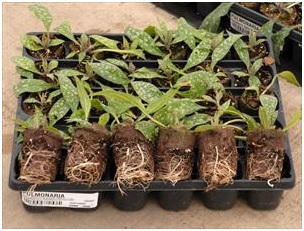Shop by Category
Shop by Brand
Shop by Brand
Pulmonaria
Early Spring Blooms & Spotted Foliage
- Shade Tolerance: It thrives in partial to full shade, making it perfect for brightening up woodland gardens, north-facing beds, or areas under trees and shrubs where other plants struggle.
- Early Spring Color: Pulmonaria is one of the first perennials to bloom in spring, offering cheerful clusters of flowers often starting pink and maturing to blue or purple (though some varieties stay one color or are white).
- Attractive Foliage: Even after blooming, most Pulmonaria varieties offer striking foliage, often silver-spotted, splashed, or edged, providing visual interest throughout the growing season. Some newer varieties have almost entirely silver leaves.
- Low Maintenance: Once established, Lungwort is relatively easy to care for, requiring minimal fuss.
- Pollinator Friendly: The early blooms are a valuable nectar source for emerging bees and other early pollinators.
- Deer and Rabbit Resistant: Generally, deer and rabbits tend to leave Pulmonaria alone due to its slightly fuzzy leaves.
- Ground Cover Potential: While typically forming neat clumps, they can slowly spread to form an attractive ground cover in shady spots.
- Hardiness Zones: Generally hardy in USDA zones 3-9, depending on the specific cultivar.
- When to Plant: Plant container-grown Pulmonaria in spring or early fall. Avoid planting during the intense heat of mid-summer.
- Light Requirements: Prefers partial shade (morning sun is okay) to full shade. Too much direct sun, especially hot afternoon sun, can scorch the leaves.
- Soil: Needs consistently moist, humus-rich, well-draining soil. They dislike both drought and soggy conditions. Amend poor soils with compost or other organic matter before planting to improve structure and fertility. A slightly acidic to neutral pH is generally preferred.
- Planting:
- Dig a hole slightly wider than the plant's root ball and about the same depth.
- Gently remove the plant from its pot and loosen any tightly bound roots.
- Place the plant in the hole so the top of the root ball is level with the surrounding soil surface.
- Backfill the hole with soil, gently firming it around the roots.
- Water thoroughly after planting.
- Spacing: Space plants about 12-18 inches apart, depending on the mature size of the variety, to allow for good air circulation.
- Watering: Water regularly, especially during dry periods, to keep the soil consistently moist but not waterlogged. Consistent moisture is key, particularly during the growing season and bloom time.
- Mulching: Apply a 2–3-inch layer of organic mulch (like shredded bark or compost) around the plants (but not touching the crowns) to help retain soil moisture, suppress weeds, and keep roots cool.
- Fertilizing: Pulmonaria is not a heavy feeder. An application of compost or a balanced slow-release fertilizer in early spring is usually sufficient. Avoid over-fertilizing.
- Maintenance & Pruning:
- Remove any tattered or damaged leaves after winter before new growth emerges.
- After flowering, if the foliage looks tired or damaged (e.g., by slugs or mildew), you can cut it back hard to encourage a fresh flush of leaves. However, many gardeners leave the attractive foliage intact through the season.
- Deadheading (removing spent flowers) is not strictly necessary but can keep the plant looking tidier.
- Division: Divide clumps every 3-5 years in early spring or fall if they become overcrowded or the center starts to die out. This rejuvenates the plant and provides new plants to spread around the garden.
- Pests and Diseases:
- Powdery Mildew: This is the most common issue, especially in humid conditions or if plants are overcrowded with poor air circulation. Choose resistant varieties, ensure good spacing, and avoid overhead watering if possible. Remove affected leaves promptly.
- Slugs and Snails: These pests can sometimes chew holes in the leaves. Use appropriate controls if they become a problem.
By providing the right conditions, Pulmonaria will reward you with early spring beauty and attractive foliage for much of the growing season.

Pulmonaria (pull-mon-nay-ree-uh) Lungwort; Boraginaceae Family. Pulmonaria are European perennials with spotted, hairy leaves, and pretty, funnel-shaped flowers in clusters. They are easily grown with ordinary soil in shade or partial shade, with ample moisture. Plants may need dividing every 3 or 4 years for best bloom.
Pulmonarias are easily grown in average, medium, well-drained soil, but prefer cool soils that are highly organic and moisture retentive. While dry conditions can lead to powdery mildew and leaf scorch, Lungwort is intolerant of wet, poorly drained soils. Prune to ground level for a fresh foliage growth. Best time to divide clumps is in the fall.
Attributes: Border plants, Container, Cut flower, Edging, Mass Planting. Attracts hummingbirds. Deer and rabbit resistant.
